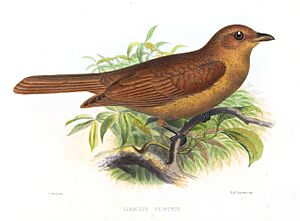Rufous piha facts for kids
Quick facts for kids Rufous piha |
|
|---|---|
 |
|
| Conservation status | |
| Scientific classification | |
| Genus: |
Lipaugus
|
| Species: |
unirufus
|
 |
|
The rufous piha (Lipaugus unirufus) is a type of bird. It belongs to the Cotingidae family. You can find this bird in many countries in Central and South America. These include Belize, Colombia, Costa Rica, Ecuador, Guatemala, Honduras, Mexico, Nicaragua, and Panama. It likes to live in warm, wet lowland forests.
What Does the Rufous Piha Look Like?
An adult rufous piha is about 23.5 cm (9.3 in) long. Male and female birds look very similar. Their top feathers are a reddish-cinnamon color. Their belly feathers are a bit lighter. The throat is the lightest part of their body.
The bird has a wide bill. Its bill can be flesh-colored or brown at the bottom. Sometimes, there is a light ring around its eye. This bird might look like the speckled mourner. However, the speckled mourner is shorter and thinner. It also has a more slender bill and a longer tail. The male rufous piha makes loud, whistling calls.
Life and Habits of the Rufous Piha
The rufous piha lays its eggs between March and August in Costa Rica. It might have two sets of babies each year. This bird mostly eats fruits. It enjoys fruits from laurel trees and palm trees. It also eats small creatures like insects and spiders.
The rufous piha lives in the middle and lower parts of humid forests. It rarely goes down to the ground. It often picks up food while hovering in the air. If it finds food on the ground, it carries it up to eat. The bird can sit quietly on a branch for a long time. Then, it will quickly fly out to catch insects passing by.
Is the Rufous Piha in Danger?
The rufous piha lives across a very large area. There are many of these birds. Scientists believe there are between 50,000 and 500,000 rufous pihas. Their numbers might be slowly going down. This is mainly because of forests being cut down. This is happening especially in Colombia and Ecuador.
However, the population is not shrinking fast enough to be a big worry. So, the International Union for Conservation of Nature says it is a "least-concern species". This means it is not currently threatened with extinction.



